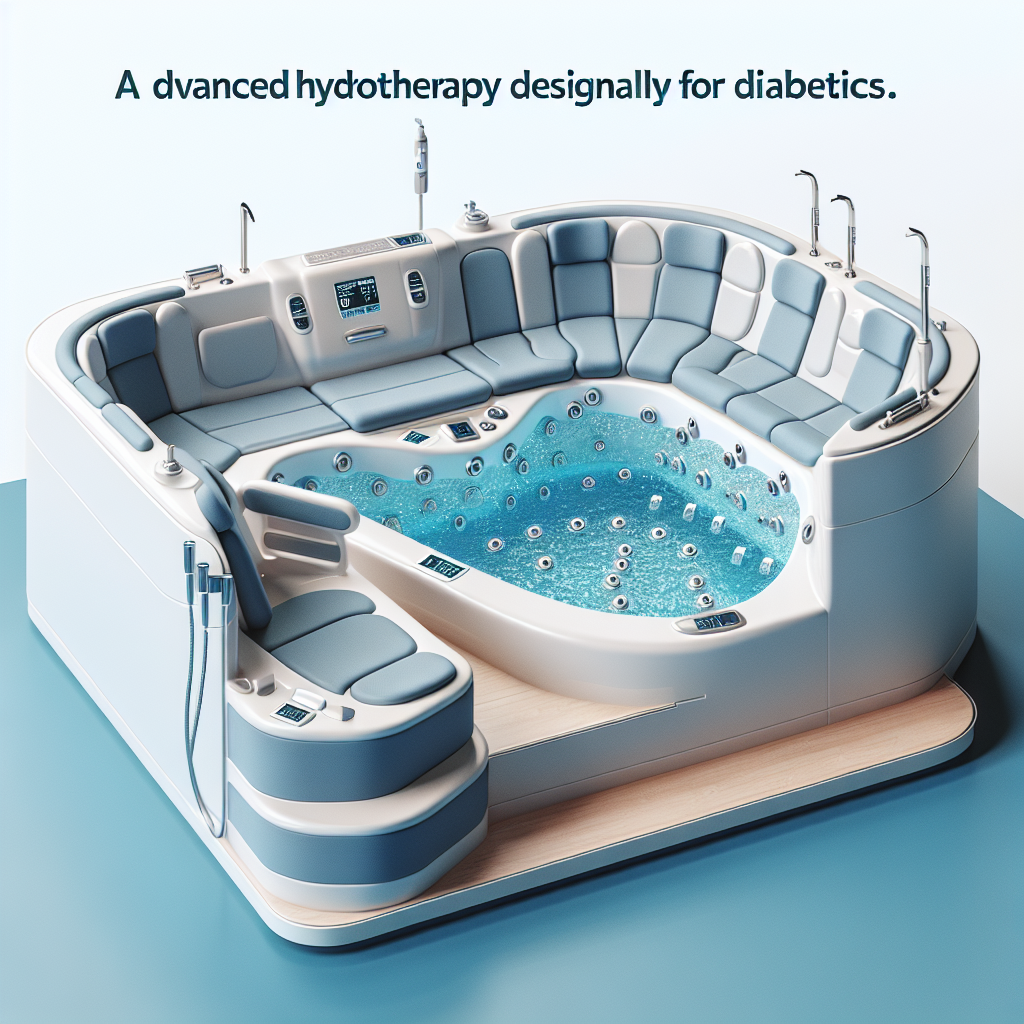
-
Hydrotherapy can help improve circulation and potentially regulate blood glucose levels in diabetics.
-
Choosing the right bath involves considerations like ergonomic design, temperature control, and safety features.
-
Walk-in tubs and air tubs are among the suitable options for diabetic hydrotherapy, each with unique benefits.
-
It’s critical to maintain safe bath temperatures to prevent burns, especially for diabetics with neuropathy.
-
Accessibility and user-friendly controls are essential for a therapeutic and comfortable hydrotherapy experience.
Understanding the Importance of Hydrotherapy for Diabetics

When we talk about hydrotherapy, we’re not just referring to a relaxing soak in the tub. For diabetics, hydrotherapy is a therapeutic practice that can play a significant role in managing the condition. The warmth and buoyancy of water can work wonders on the body, helping to improve circulation and potentially regulate blood glucose levels. This is crucial because good circulation promotes better healing, and stable glucose levels can prevent complications associated with diabetes.
Benefits of Hydrotherapy in Regulating Blood Glucose
Imagine a therapy that not only eases your stress but also helps in managing your diabetes. Hydrotherapy can be that double-edged sword for diabetics. Studies have shown that the increased blood flow from the warm water can help reduce blood glucose levels. This happens because as your body warms up, your blood vessels dilate, allowing more nutrient-rich blood to flow through your muscles, thus helping in glucose uptake.
How Hydrotherapy Aids Circulation and Diabetic Skin Care
For diabetics, maintaining skin integrity is a top priority, and that’s where hydrotherapy steps in. The improved circulation from a warm bath can promote better skin health, reducing the risks of infections and ulcers that are common concerns for diabetic individuals. Therefore, it’s not just about the immediate relaxation, but also about the long-term benefits that hydrotherapy can offer to diabetics.
Key Factors in Selecting the Right Hydrotherapy Bath
Now that you’re aware of the health benefits, let’s dive into how to choose the right hydrotherapy bath. It’s not as simple as picking any tub off the shelf. Diabetics have unique needs, and the bath must meet these to be effective and safe.
Assessing Ergonomic Design and Comfort
Comfort is key in hydrotherapy. You want a bath that supports your body without causing additional strain. Look for tubs with built-in seats, armrests, and back supports. These features can make a significant difference in your bathing experience, especially if you have mobility issues or need to soak for extended periods.
Temperature Control and Safety Measures
For diabetics, especially those with neuropathy, sensing extreme temperatures can be difficult. That’s why having precise temperature control in your hydrotherapy bath is vital. It helps prevent accidental burns and ensures the water is at a therapeutic temperature that promotes blood flow without causing harm.
Ensuring Safe Bath Temperatures for Diabetics
One of the most crucial considerations for diabetic hydrotherapy is the bath temperature. Diabetics often suffer from neuropathy, which can dull the sensation of heat, increasing the risk of burns. Therefore, it’s essential to have a fail-safe way to ensure the bath water is at a safe temperature before getting in.
Optimal Temperature Ranges to Prevent Burns
The optimal temperature range for a hydrotherapy bath for diabetics should be warm but not hot, typically between 92°F to 100°F (33°C to 38°C). At this range, the water is warm enough to stimulate circulation without posing a risk for burns or overheating.
It’s also important to gradually increase the water temperature, especially if you’re new to hydrotherapy. This allows your body to adjust and also gives you a chance to gauge how your skin reacts to the warmth. Remember, the goal is therapeutic relief, not thermal shock.
-
Start with a lower temperature and gradually increase to your comfort level.
-
Always check the water temperature with a thermometer if you have reduced sensation in your extremities.
-
Avoid hydrotherapy if you have open wounds or severe neuropathy until you consult with your healthcare provider.
Most importantly, never underestimate the power of water temperature. Even a few degrees too hot can lead to complications, so always err on the side of caution.
Using Thermostatic Controls for Precision
Thermostatic controls are a game-changer for maintaining the right water temperature. These controls allow you to set and maintain a precise temperature throughout your hydrotherapy session. This means no unexpected changes in water temperature, reducing the risk of burns.
With thermostatic controls, you can focus on relaxing and enjoying the therapeutic benefits of your bath, knowing that the water will stay at a safe, consistent temperature.
Top Safety Features in Hydrotherapy Tubs

When it comes to hydrotherapy tubs, safety should be at the forefront of design. This is especially true for diabetics, who need to be mindful of additional risks such as infections and slow wound healing.
Here are some key safety features to look for:
-
Non-slip flooring to prevent falls when entering or exiting the tub.
-
Easy-to-reach controls to adjust water jets and temperature without strain.
-
Built-in seats and handrails to provide stability and support.
-
Anti-scald devices to prevent the water from reaching dangerous temperatures.
By choosing a tub with these safety features, you’re not just investing in a piece of equipment; you’re investing in your wellbeing.
Significance of Non-Slip Surfaces
Non-slip surfaces are non-negotiable. The bathroom can be a hazardous place, with wet surfaces leading to slips and falls. This is a serious concern for everyone, but it’s especially critical for diabetics, who may have balance issues due to neuropathy or may be more prone to injuries. A hydrotherapy tub with a non-slip floor can provide the confidence you need to bathe independently and safely.
The Role of Grab Bars and Handrails
Grab bars and handrails are like silent guardians in your bathroom. They offer a sturdy support system, helping you navigate in and out of the tub with ease. For diabetics, this is invaluable as it reduces the risk of falls and the potential for injury that can be complicated by diabetes-related health issues.
Making Hydrotherapy Baths Accessible
Accessibility is a crucial component of hydrotherapy for diabetics. You want a bath that’s easy to enter and exit, minimizing strain and the risk of injury. This is where design elements such as low thresholds and door systems come into play.
Addressing Entry and Exit Needs with Low Thresholds
Low-threshold tubs are designed to make getting in and out of the bath as easy as stepping over a small bump. This feature is particularly beneficial for those with limited mobility or balance issues. By removing the need to climb over a high tub wall, you’re significantly reducing the risk of falls.
Customizations for Enhanced Mobility Support
Customization options can make all the difference in creating a hydrotherapy bath that suits your individual needs. Features such as adjustable seats, movable jets, and hand-held showerheads can all contribute to a more comfortable and therapeutic bathing experience. These adjustments help cater to your specific physical requirements, ensuring that your hydrotherapy session is both safe and beneficial.
Finding the right balance between therapeutic benefits and personal comfort is crucial when selecting a hydrotherapy tub. You want a tub that not only caters to your diabetic needs but also offers a sanctuary for relaxation and stress relief.
Integrating Massage Features for Maximum Benefit
Massage features in hydrotherapy baths can significantly enhance the therapeutic experience. These features, such as water jets or air bubbles, can provide a gentle massage that helps stimulate circulation and relieve muscle tension. For diabetics, this can be particularly beneficial as it aids in promoting blood flow and can even help with the absorption of insulin.
Prioritizing User-Friendly Controls and Interfaces
When it comes to hydrotherapy tubs, ease of use is just as important as the therapy itself. User-friendly controls and interfaces allow you to adjust settings without hassle, ensuring a relaxing experience. Look for tubs with simple touchpad controls, easy-to-read displays, and intuitive design. This way, you can focus on your therapy without any added frustration.
FAQs About Choosing a Hydrotherapy Bath for Diabetics
Let’s address some common questions you might have when choosing a hydrotherapy bath suitable for diabetic care.
1. What Should Be the First Consideration When Choosing a Bath?
The first consideration should always be safety. Ensure the tub has non-slip surfaces, temperature controls, and safety bars. These features are paramount to prevent accidents and injuries, which can be particularly dangerous for diabetics.
2. How Can I Ensure a Hydrotherapy Bath is Diabetic-Friendly?
To ensure a hydrotherapy bath is diabetic-friendly, look for features such as adjustable water jets for massage, temperature controls to prevent burns, and ergonomic design for comfort. Consult with your healthcare provider about the specific features that would be most beneficial for your condition.
3. Are Air Tubs or Whirlpool Tubs Better for Diabetics?
Both air tubs and whirlpool tubs can be suitable for diabetics, but it often comes down to personal preference and specific health needs. Air tubs provide a gentler massage with thousands of tiny air bubbles, while whirlpool tubs offer a more intense massage with water jets. Consider your sensitivity levels and consult with a healthcare professional to determine the best option for you.
4. What Safety Features Are Essential for Diabetic Users?
Essential safety features for diabetic users include non-slip floors, temperature control systems, handrails, and a design that allows for easy entry and exit. Additionally, features such as anti-scald devices can further ensure a safe bathing experience.
5. Can I Install a Hydrotherapy Bath in a Small Bathroom?
Yes, you can install a hydrotherapy bath in a small bathroom. Many companies offer compact models designed for smaller spaces. Look for walk-in tubs or corner designs that maximize the use of space while still providing the therapeutic benefits you need.
In conclusion, choosing the right hydrotherapy bath for diabetic care requires careful consideration of safety, comfort, and therapeutic features. By focusing on these key aspects, you can find a tub that not only meets your health needs but also provides a relaxing and rejuvenating experience. Remember to consult with your healthcare provider before making any decisions, and always prioritize features that will enhance your overall well-being and safety.



Leave a Reply